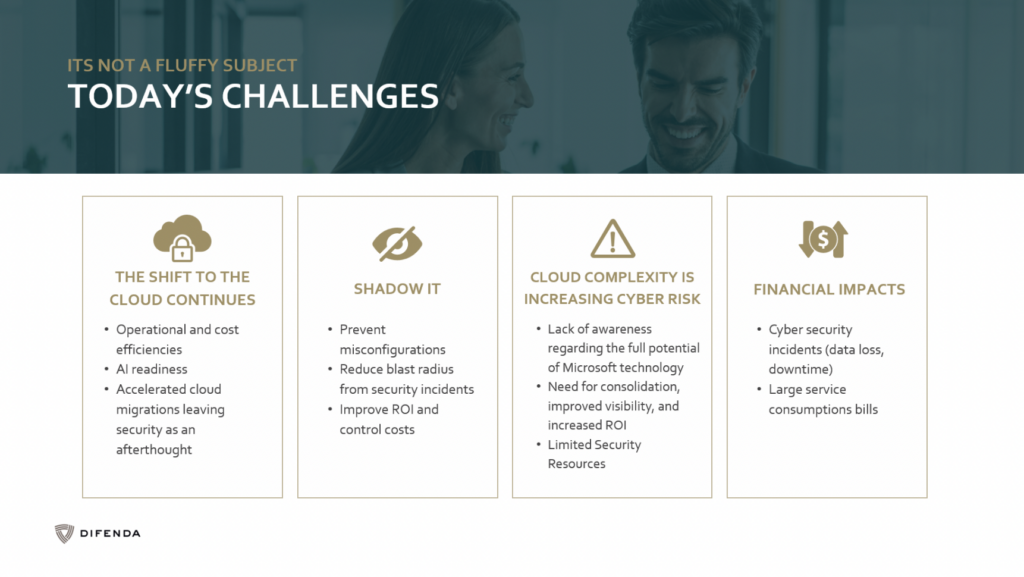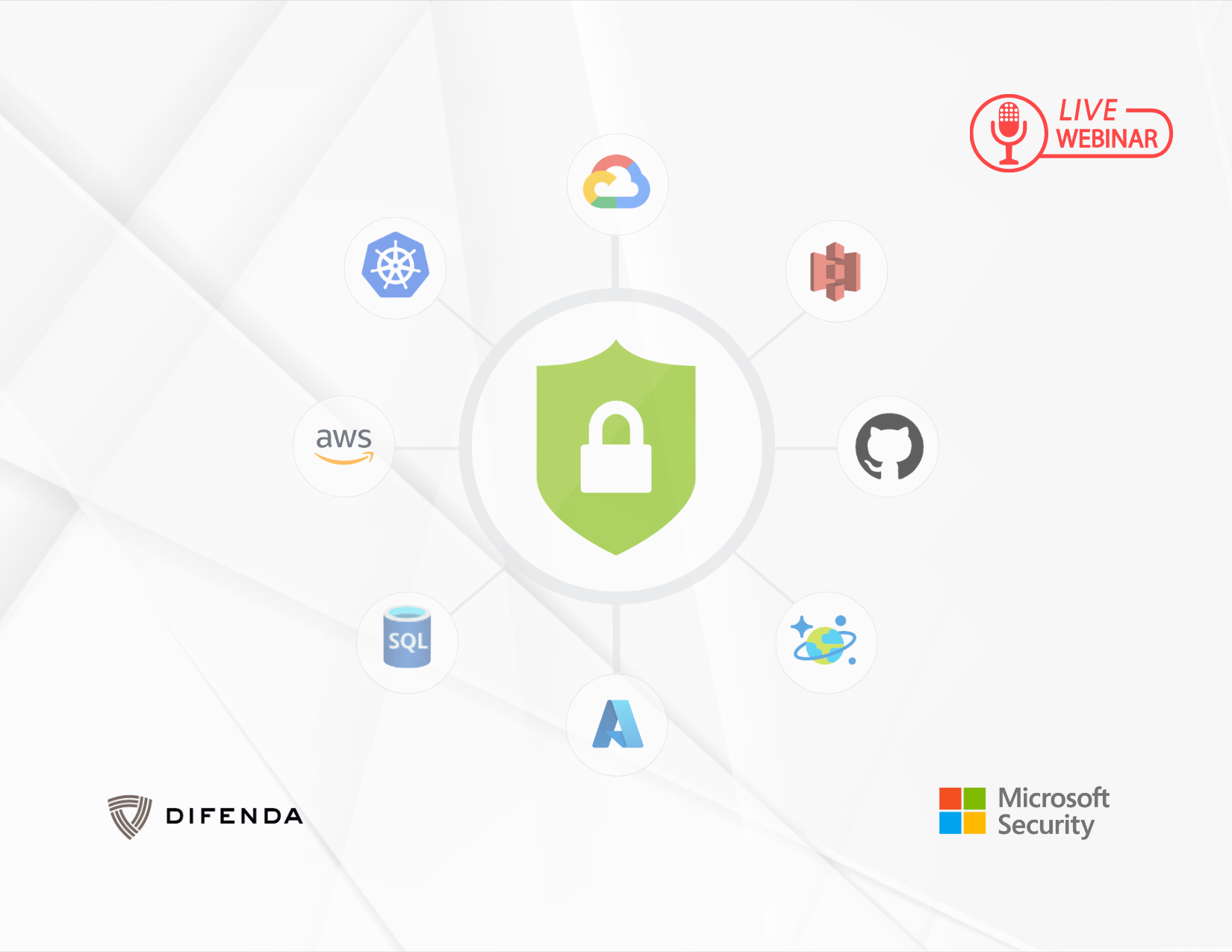In the dynamic landscape of cloud security, staying ahead means embracing innovative solutions that not only detect threats but also proactively mitigate them. This was the central theme of our latest webinar, which brought together experts from Difenda and Microsoft to discuss strategies to #OperationalizeCloudSecurity.
During the webinar, industry experts gathered to address the pivotal challenges and innovative solutions in cloud cybersecurity with Microsoft Defender for Cloud.
Here’s what you need to know.
Key Takeaways
- Companies are increasingly integrating AI for analytics and augmenting staff. With more data being uploaded to the cloud, safeguarding this data is becoming crucial.
- During cloud migrations, security is often relegated to an afterthought, leading to vulnerabilities and increased attack surfaces. Establishing robust security practices early is essential.
- Preventing misconfigurations and ensuring compliance in development and production environments is critical to avoid security breaches that could result in significant reputational damage.
- Microsoft’s Defender for Cloud is not limited to Azure. It provides multi-cloud protection, and there’s a demonstration of its application with AWS for cloud security.
- The multitude of security tools available can overwhelm a smaller SecOps team. A consolidated, powerful tool like Defender for Cloud can be more manageable.
- For small to medium-sized businesses, security often imposes a heavy burden on the budget. Tools that provide comprehensive security assessments and posture management are valuable.
- The financial ramifications of data loss, downtime, and large service consumption bills, such as those resulting from account compromise for Bitcoin mining or unprotected APIs, are significant concerns.
- Leveraging Defender for Cloud, Defender XDR, and Microsoft Sentinel integration can automate the triage, verdict, and response to threats. Enhancing security maturity and reducing time to respond (TTR) and time to detect (TTD).
- With the right configurations and automation in place, organizations can reach a high level of security maturity.
Speaker Introductions
Chad Paquette is a seasoned Architect at Difenda, specializing in Terraform automation, networking, security controls, guardrails, and DevOps pipelines. He leverages expertise in Defender for Cloud and multi-cloud platform security best practices to enhance Difenda’s professional services. Chad brings a depth of knowledge that is crucial in navigating the complexities of cloud security today.
Carlos Espinoza is Director of platform and advisory services and has spent over ten years working on cloud security solutions. He is responsible for helping our customers improve their security posture and achieve business objectives. Carlos’s strategic focus has proven his ability to develop and implement high performing Information Security Management Systems throughout his career.
Greg Wartes is an accomplished Enterprise Digital Security Specialist at Microsoft, based in Atlanta. With 16 years immersed in technology, Greg brings a wealth of experience focused primarily on cybersecurity. Throughout his journey in IT and cybersecurity, he has been a steadfast advocate for prevention-focused cybersecurity strategies.
Current Cloud Security Trends and Challenges
As cloud dependency intensifies, organizations continue to grapple with cost management and security posturing. The group highlighted the common oversight of security in cloud migrations. Highlighting that without proper controls, cloud usage can become expensive, and lead to increased vulnerabilities. Underscoring the imperative of incorporating security as a primary thought rather than an afterthought.

The concept of ‘security by design’ was stressed. Emphasizing the importance of integrating security measures right from the development phase to reduce the potential ‘blast radius’ of any breach.
Microsoft Defender for Cloud For Cloud Security
Microsoft Defender for Cloud is a comprehensive cloud security solution designed to protect not only what you run in the cloud, but also what you build in the cloud. We break it down into 3 main pillars:
- DevOps Security: This pillar secures the entire lifecycle, from development to deployment, ensuring critical misconfigurations are minimized right from the coding stage. This aligns with the philosophy of ‘shifting left,’ which integrates security early in the development lifecycle.
- Cloud Security Posture Management (CSPM): Defender for Cloud quickly assesses, identifies, and mitigates risks across various cloud environments. It provides comprehensive visibility, allowing security teams to focus on the most critical risks, thus reducing the mean time to respond (MTTR) to incidents.
- Cloud Workload Protection (CWP): This component extends protection to a broad range of cloud services and resources such as servers, containers, service layers, databases, and storage APIs. It includes agentless vulnerability scanning, real-time threat detection, and response, as well as seamless integration with SIEM systems to facilitate in-depth attack investigations and automated response actions.
According to Greg, the goal of Defender for Cloud is to foster a security culture where prevention is prioritized and the common goal is maintaining a proactive security posture. Defender for Cloud aims to mature an organization’s security practices through automation and integrated management of security across cloud services.
Demo: Connecting Microsoft Defender for Cloud to an AWS Account
Chad Paquette demonstrated how seamlessly Microsoft Defender for Cloud can be integrated with an AWS account. He meticulously walked through the environment setup, highlighting the importance of using the service for resource scanning and assessment. This integration is pivotal for businesses looking to bolster their cloud security posture across multiple cloud environments.
The demo highlighted strategies like employing security guardrails and addressing the complexities of multi-cloud environments, including shadow IT and lateral threats.
Demo: Difenda Cloud Threat Detection and Response
By leveraging the integration between Microsoft Defender for Cloud, Defender XDR, and Microsoft Sentinel, Carlos Espinoza illustrated how organizations could automate triage, verdict determination, and timely responses to threats.
And showcased the high maturity level that can be achieved using MDC in conjunction with other Microsoft security tools. Through automation, entities could swiftly process and respond to alerts. Underlining the advanced detection capabilities and the refined configurations possible with Microsoft’s security stack. The scenario exemplified how these integrated solutions can elevate an organization’s cybersecurity defences to Level 4 maturity by implementing automation on top of detection to enhance protection and response actions effectively.
Conclusion
The two demonstrations showcased the robust capabilities of Microsoft Defender for Cloud. Especially when complemented by the automation and analytics power of Defender XDR and Microsoft Sentinel. These tools collectively create a proactive, multi-layered defense strategy.
DEMYSTIFYING DEFENDER FOR CLOUD WEBINAR


